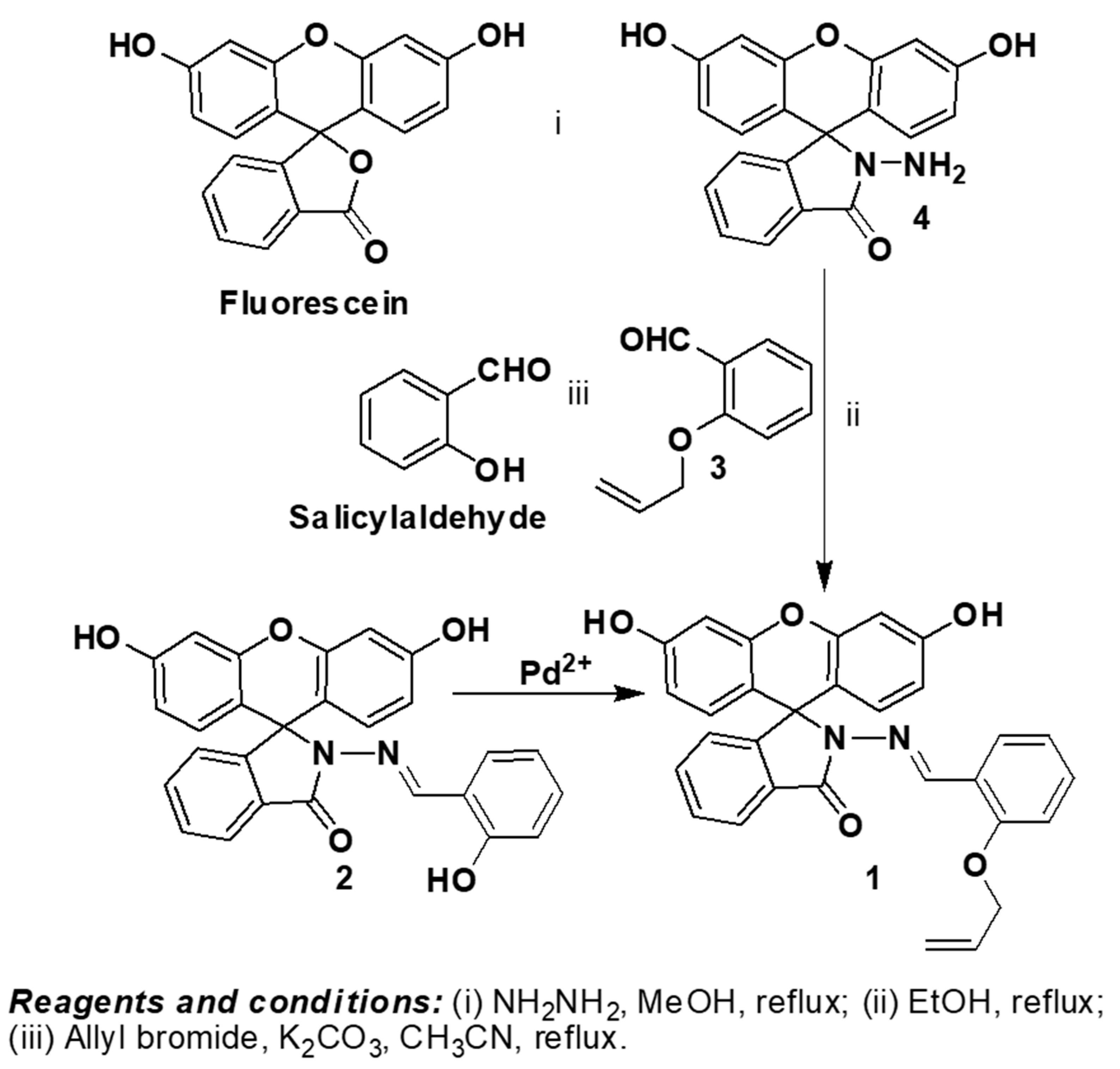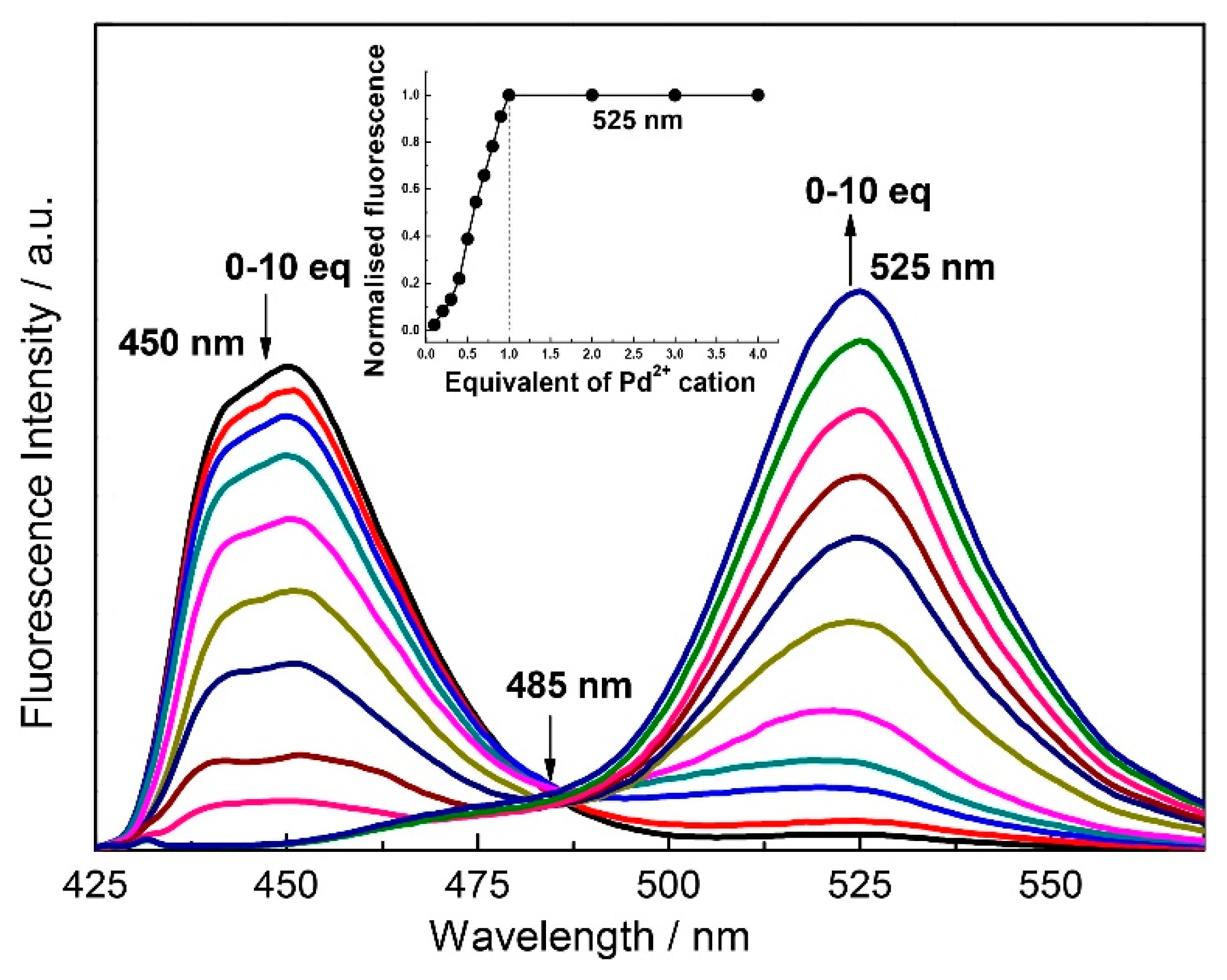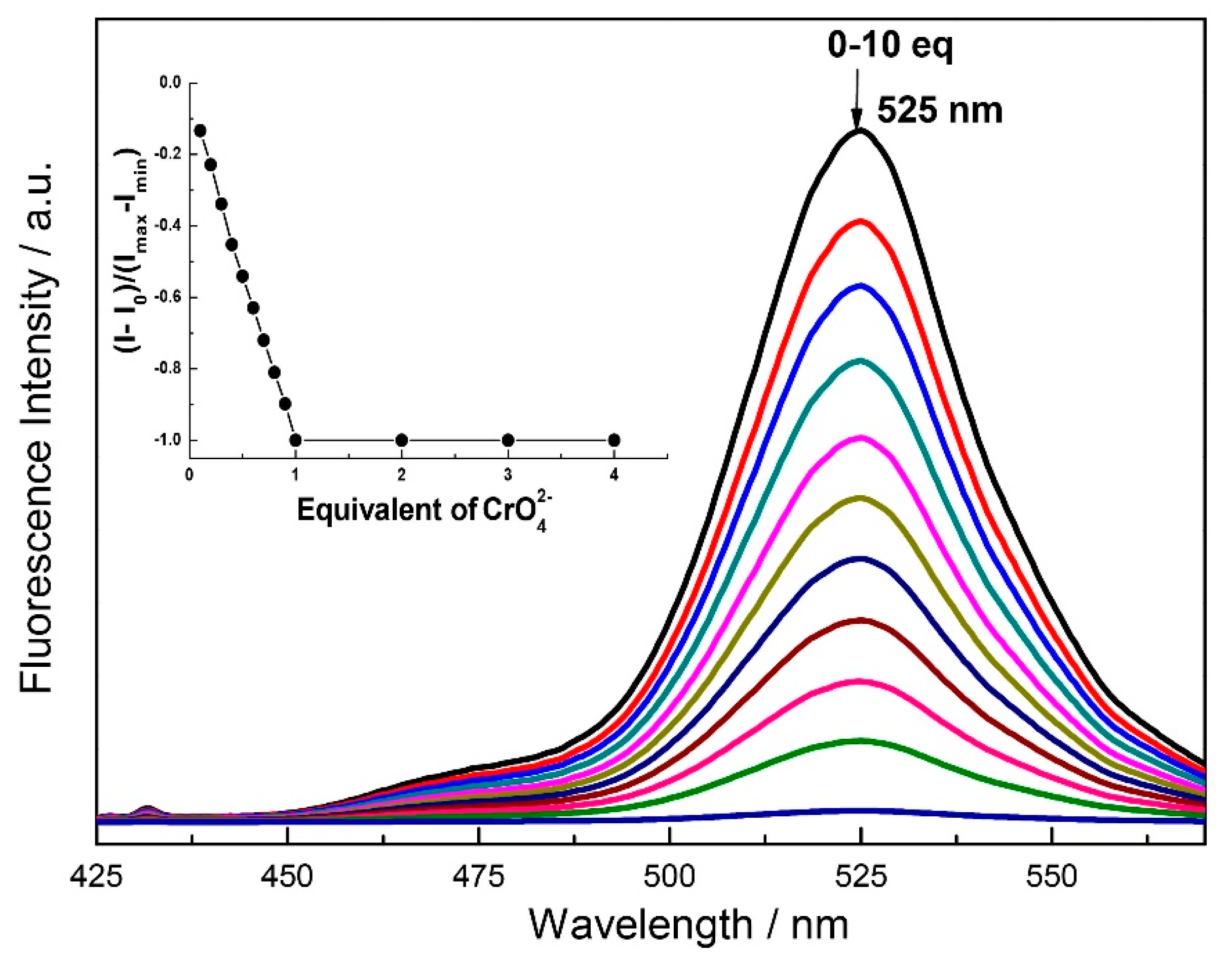Sequential Detection of Palladium and Chromium Oxyanion by a Fluorescein Based Chemosensor in Mixed Aqueous Media
Abstract
:1. Introduction
2. Materials and Methods
2.1. General Methods
2.2 Synthesis
2.2.1. Synthesis of 3
2.2.2. Synthesis of 1
2.2.3. Synthesis of 2
3. Results and Discussion
4. Conclusions
Supplementary Materials
Funding
Acknowledgments
Conflicts of Interest
References
- Liu, C.; Zhang, S.K.; Zhang, Y.X.; Jin, Z.L. Arylation of pyridine N-oxides via a ligand-free Suzuki reaction in water. Chin. Chem. Lett. 2015, 26, 55–57. [Google Scholar] [CrossRef]
- Tietze, L.F.; Ila, H.; Bell, H.P. Enantioselective palladium-catalyzed transformations. Chem. Rev. 2004, 104, 3453–3516. [Google Scholar] [CrossRef] [PubMed]
- Amini, M.; Bagherzadeh, M.; Rostamnia, S. Efficient imidazolium salts for palladium-catalyzed Mizoroki–Heck and Suzuki–Miyaura cross-coupling reactions. Chin. Chem. Lett. 2013, 24, 433–436. [Google Scholar] [CrossRef]
- Lyons, T.W.; Sanford, M.S. Palladium-catalyzed ligand-directed C−H functionalization reactions. Chem. Rev. 2010, 110, 1147–1169. [Google Scholar] [CrossRef] [PubMed] [Green Version]
- Lafrance, M.; Fagnou, K. Palladium-catalyzed benzene arylation: Incorporation of catalytic pivalic acid as a proton shuttle and a key element in catalyst design. J. Am. Chem. Soc. 2006, 128, 16496–16497. [Google Scholar] [CrossRef] [PubMed]
- Alt, F.; Zereini, F. Palladium Emissions in the Environment Analytical Methods, Environmental Assessment and Health Effects; Springer: Berlin, Germany, 2006. [Google Scholar]
- Li, H.; Fan, J.; Peng, X. Colourimetric and fluorescent probes for the optical detection of palladium ions. Chem. Soc. Rev. 2013, 42, 7943–7962. [Google Scholar] [CrossRef]
- Wang, J.; Song, F.; Wang, J.; Peng, X. A near-infrared and ratiometric fluorescent chemosensor for palladium. Analyst 2013, 138, 3667–3672. [Google Scholar] [CrossRef]
- Meel, K.V.; Smekens, A.; Behets, M.; Kazandjian, P.; Grieken, R.V. Determination of platinum, palladium, and rhodium in automotive catalysts using high-energy secondary target X-ray fluorescence spectrometry. Anal. Chem. 2007, 79, 6383–6389. [Google Scholar] [CrossRef]
- Dimov, S.S.; Chryssoulis, S.L.; Lipson, R.H. Quantitative elemental analysis for rhodium and palladium in minerals by time-of-flight resonance ionization mass spectrometry. Anal. Chem. 2003, 75, 6723–6727. [Google Scholar] [CrossRef]
- Carter, K.P.; Young, A.M.; Palmer, A.E. Fluorescent sensors for measuring metal ions in living systems. Chem. Rev. 2014, 114, 4564–4601. [Google Scholar] [CrossRef]
- Huo, B.; Du, M.; Gong, A.; Li, M.; Fang, L.; Shen, A.; Lai, Y.; Bai, X.; Yang, Y. A novel intramolecular cyclization-induced fluorescent “turn-on” probe for detection of Pd2+ based on the Tsuji-Trost reaction. Anal. Methods 2018, 10, 3475–3480. [Google Scholar] [CrossRef]
- Che, C.; Chen, X.; Wang, H.; Li, J.Q.; Xiao, Y.; Fu, B.; Qin, Z. A novel 6-quinoxalinamine-based fluorescent probe for real-time detection of palladium (II) ions in pure water and bio-imaging. New J. Chem. 2018, 42, 12773–12778. [Google Scholar] [CrossRef]
- Mondal, S.; Manna, S.K.; Pathak, S.; Masum, A.A.; Mukhopadhyay, S. A colorimetric and “off–on” fluorescent Pd2+ chemosensor based on a rhodamine-ampyrone conjugate: Synthesis, experimental and theoretical studies along with in vitro applications. New J. Chem. 2019, 43, 3513–3519. [Google Scholar] [CrossRef]
- Kim, H.N.; Ren, W.; Kim, J.S.; Yoon, J. Fluorescent and colorimetric sensors for detection of lead, cadmium, and mercury ions. Chem. Soc. Rev. 2012, 41, 3210–3244. [Google Scholar] [CrossRef] [PubMed]
- Jun, M.E.; Ahn, K.H. Fluorogenic and chromogenic detection of palladium species through a catalytic conversion of a rhodamine B derivative. Org. Lett. 2010, 12, 2790–2793. [Google Scholar] [CrossRef] [PubMed]
- Pershagen, E.; Nordholm, J.; Borbas, K.E. Luminescent Lanthanide Complexes with Analyte-Triggered Antenna Formation. J. Am. Chem. Soc. 2012, 134, 9832–9835. [Google Scholar] [CrossRef]
- Balamurugan, R.; Chien, C.C.; Wu, K.-M.; Chiu, Y.-H.; Li, J.-H. A depropargylation-triggered fluorescence “turn-on” probe for the detection of Pd2+ based on a bispropargylamine–rhodamine conjugate. Analyst 2013, 138, 1564–1569. [Google Scholar] [CrossRef]
- Song, F.; Garner, A.L.; Koide, K. A highly sensitive fluorescent sensor for palladium based on the allylic oxidative insertion mechanism. J. Am. Chem. Soc. 2007, 129, 12354–12355. [Google Scholar] [CrossRef]
- Yu, S.; Rhee, H.-W.; Hong, J.-I. Fluorescent sensing system for palladium (II) based on the Heck reaction. Tetrahedron Lett. 2011, 52, 1512–1514. [Google Scholar] [CrossRef]
- Yusop, R.M.; Unciti-Broceta, A.; Johansson, E.M.V.; Sánchez-Martín, R.M.; Bradley, M. Palladium-mediated intracellular chemistry. Nat. Chem. 2011, 3, 239–243. [Google Scholar] [CrossRef]
- Ashwina, B.C.M.A.; Sivaraman, G.; Stalina, T.; Yuvakkumar, R.; Mareeswarana, P.M. Selective and sensitive fluorescent sensor for Pd2+ using coumarin 460 for real-time and biological applications. J. Photochem. Photobiol. B 2018, 183, 302–308. [Google Scholar] [CrossRef] [PubMed]
- Zhitkovich, A. Importance of chromium-DNA adducts in mutagenicity and toxicity of chromium (VI). Chem. Res. Toxicol. 2005, 18, 3–11. [Google Scholar] [CrossRef] [PubMed]
- Bagchi, D.; Stohs, S.J.; Downs, B.W.; Bagchi, M.; Preuss, H.G. Cytotoxicity and oxidative mechanisms of different forms of chromium. Toxicology 2002, 180, 5–22. [Google Scholar] [CrossRef]
- Vonburg, R.; Liu, D. Chromium and Hexavalent Chromium. J. Appl. Toxicol. 1993, 13, 225–230. [Google Scholar] [CrossRef]
- Khezami, L.; Capart, R. Removal of chromium (VI) from aqueous solution by activated carbons: Kinetic and equilibrium studies. J. Hazard. Mater. 2005, 123, 223–231. [Google Scholar] [CrossRef]
- Kamaludeen, S.P.B.; Megharaj, M.; Juhasz, A.L.; Sethunathan, N.; Naidu, R. Chromium-microorganism interactions in soils: Remediation implications. Rev. Environ. Contam. Toxicol. 2003, 178, 93–164. [Google Scholar]
- Rakhunde, R.; Deshpande, L.; Juneja, H.D. Chemical speciation of chromium in water: A review. Crit. Rev. Environ. Sci. Technol. 2012, 42, 776–810. [Google Scholar] [CrossRef]
- Mohandossa, S.; Sivakamavallib, J.; Vaseeharanb, B.; Stalina, T. Host-guest molecular recognition based fluorescence On-Off-On chemosensor for nanomolar level detection of Cu2+ and Cr2O72− ions: Application in XNOR logic gate and human lung cancer living cell imaging. Sens. Actuators B Chem. 2016, 234, 300–315. [Google Scholar] [CrossRef]
- Prakash, A.; Chandra, S.; Bahadur, D. Structural, magnetic, and textural properties of iron oxide-reduced graphene oxide hybrids and their use for the electrochemical detection of chromium. Carbon 2012, 50, 4209–4219. [Google Scholar] [CrossRef]
- Zheng, H.; Zhan, X.-Q.; Biana, Q.-N.; Zhang, X.-J. Advances in modifying fluorescein and rhodamine fluorophores as fluorescent chemosensors. Chem. Commun. 2013, 49, 429–447. [Google Scholar] [CrossRef]
- Chen, X.; Pradhan, T.; Wang, F.; Kim, J.S.; Yoon, J. Fluorescent chemosensors based on spiroring-opening of xanthenes and related derivatives. Chem. Rev. 2011, 112, 1910–1956. [Google Scholar] [CrossRef] [PubMed]
- Xiong, X.Q.; Song, F.L.; Chen, G.W.; Sun, W.; Wang, J.Y.; Gao, P. Construction of Long-Wavelength Fluorescein Analogues and Their Application as Fluorescent Probes. Chem. Eur. J. 2013, 19, 6538–6545. [Google Scholar] [CrossRef] [PubMed]
- An, J.M.; Yan, M.H.; Yang, Z.Y.; Li, T.R.; Zhou, Q.X. A turn-on fluorescent sensor for Zn (II) based on fluorescein-coumarin conjugate. Dyes Pigment. 2013, 99, 1–5. [Google Scholar] [CrossRef]
- Jua, H.; Lee, M.H.; Kim, J.; Kim, J.S.; Kim, J. Rhodamine-based chemosensing monolayers on glass as a facile fluorescent “turn-on” sensing film for selective detection of Pb2+. Talanta 2011, 83, 1359–1363. [Google Scholar] [CrossRef]
- Wang, M.; Liu, X.; Lu, H.; Wang, H.; Qin, Z. Highly Selective and Reversible Chemosensor for Pd2+ Detected by Fluorescence, Colorimetry, and Test Paper. ACS. Appl. Mater. Interfaces 2015, 7, 1284–1289. [Google Scholar] [CrossRef]
- Helal, A.; Kim, H.-S.; Yamani, Z.H.; Shaikh, M.N. Fluorescein-N-Methylimidazole Conjugate as Cu2+ Sensor in Mixed Aqueous Media Through Electron Transfer. J. Fluoresc. 2016, 26, 1–9. [Google Scholar] [CrossRef]
- Sivaram, G.; Chellappa, D. Rhodamine based sensor for naked-eye detection and live cell imaging of fluoride ions. J. Mater. Chem. B 2013, 1, 5768–5772. [Google Scholar] [CrossRef]
- Yin, W.; Zhu, H.; Wang, R. A sensitive and selective fluorescence probe based fluorescein for detection of hypochlorous acid and its application for biological imaging. Dyes Pigment. 2014, 107, 127–132. [Google Scholar] [CrossRef]
- Thordarson, P. Determining association constants from titration experiments in supramolecular chemistry. Chem. Soc. Rev. 2011, 40, 1305–1323. [Google Scholar] [CrossRef]
- Zhu, B.; Zhang, X.; Li, Y.; Wang, P.; Zhang, H.; Zhuang, X. A colorimetric and ratiometric fluorescent probe for thiols and its bioimaging applications. Chem. Commun. 2010, 46, 5710–5712. [Google Scholar] [CrossRef]
- Egawa, T.; Koide, Y.; Hanaoka, K.; Komatsu, T.; Teraia, T.; Nagano, T. Development of a fluorescein analogue, Tokyo Magenta, as a novel scaffold for fluorescence probes in red region. Chem. Commun. 2011, 47, 4162–4164. [Google Scholar] [CrossRef] [PubMed]
- Ueno, T.; Urano, Y.; Setsukinai, K.; Takakusa, H.; Kojima, H.; Kikuchi, K.; Ohkubo, K.; Fukuzumi, S.; Nagano, T. Rational principles for modulating fluorescence properties of fluorescein. J. Am. Chem. Soc. 2004, 126, 14079–14085. [Google Scholar] [CrossRef] [PubMed]
- Kumar, A.; Kim, H.-S. N-(3-Imidazolyl) propyl dansylamide as a selective Hg2+ sensor in aqueous media through electron transfer. Spectrochim. Acta Part A Mol. Biomol. Spectrosc. 2015, 148, 250–254. [Google Scholar] [CrossRef] [PubMed]
- Kumar, A.; Kim, H.S. A pyrenesulfonyl-imidazolium derivative as a selective cyanide ion sensor in aqueous media. New J. Chem. 2015, 39, 2935–2942. [Google Scholar] [CrossRef]
- Hens, A.; Maity, A.; Rajak, K.K. N, N coordinating schiff base ligand acting as a fluorescence sensor for zinc (II) and colorimetric sensor for copper (II), and zinc (II) in mixed aqueous media. Inorg. Chim. Acta 2014, 423, 408–420. [Google Scholar] [CrossRef]
- Kavallieratos, K.; Rosenberg, J.M.; Chen, W.-Z.; Ren, T. Fluorescent sensing and selective Pb (II) extraction by a dansylamide ion-exchanger. J. Am. Chem. Soc. 2005, 127, 6514–6515. [Google Scholar] [CrossRef] [Green Version]
- Santra, M.; Roy, B.; Ahn, K.H. A “reactive” ratiometric fluorescent probe for mercury species. Org. Lett. 2011, 13, 3422–3425. [Google Scholar] [CrossRef]
- Ding, J.; Yuan, L.; Gao, L.; Chen, J. Fluorescence quenching of a rhodamine derivative: Selectively sensing Cu2+ in acidic aqueous media. J. Lumin. 2012, 132, 1987–1993. [Google Scholar] [CrossRef]
- Bua, F.; Zhao, B.; Kan, W.; Ding, L.; Liu, T.; Wang, L.; Song, B.; Wang, W.; Deng, Q. An ESIPT characteristic “turn-on” fluorescence sensor for Hg2+ with large Stokes shift and sequential “turn-off” detection of S2− as well as the application in living cells. J. Photochem. Photobiol. A 2020, 387, 112165–112174. [Google Scholar] [CrossRef]









© 2019 by the author. Licensee MDPI, Basel, Switzerland. This article is an open access article distributed under the terms and conditions of the Creative Commons Attribution (CC BY) license (http://creativecommons.org/licenses/by/4.0/).
Share and Cite
Helal, A. Sequential Detection of Palladium and Chromium Oxyanion by a Fluorescein Based Chemosensor in Mixed Aqueous Media. Chemosensors 2020, 8, 4. https://doi.org/10.3390/chemosensors8010004
Helal A. Sequential Detection of Palladium and Chromium Oxyanion by a Fluorescein Based Chemosensor in Mixed Aqueous Media. Chemosensors. 2020; 8(1):4. https://doi.org/10.3390/chemosensors8010004
Chicago/Turabian StyleHelal, Aasif. 2020. "Sequential Detection of Palladium and Chromium Oxyanion by a Fluorescein Based Chemosensor in Mixed Aqueous Media" Chemosensors 8, no. 1: 4. https://doi.org/10.3390/chemosensors8010004




